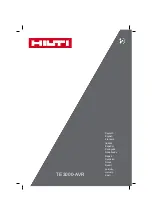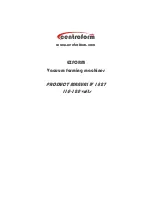
EN
EN-2
51955631_ed5
WARNING
Attach safety cables across hose couplings & fittings and install safety locking pins or clips on coupling to prevent whipping air
hoses.
Blow out the main air supply hose to get rid of moisture, rubber particles and dirt before attaching the hose to the tool.
WARNING
Compressed air is dangerous. When blowing out an air hose, hold it firmly and point it away from personnel and equipment. Never
blow your clothes free of dust with compressed air.
Make sure all hoses and fittings are the correct size and are tightly secured. See diagram Dwg. 16572133 on page 2 for a typical piping
arrangement.
Air Requirements
An air compressor of sufficient capacity is needed to provide the necessary volume of air at the most efficient operating pressure to ensure
effective and economical operation of the Paving Breaker. The air requirements represent air pressure at the Paving Breaker inlet and not at the
compressor. There is always a certain amount of pressure drop between the compressor and the Paving Breaker; only the pressure and volume
at the tool is effective in doing work. If a hose is relatively short and in good condition, the pressure drop between the compressor (or air
receiver) and the Paving Breaker should not exceed 15 percent of the initial pressure.
Low or inadequate air pressure at the Paving Breaker is costly and wasteful, and an insufficient volume if air will not allow it to operate
efficiently.
Lubrication
The paving breaker is initially supplied with a small amount of lubricating oil in the paving breaker lubrication reservoir, but should be checked
and filled before use. Always check the oil level in the reservoir before each start up.
Methods Of Lubrication
Proper lubrication is the most important single factor responsible for the service life of the pneumatic paving breaker. A paving breaker can be
severely damaged during the first few minutes of operation if it is not properly lubricated.
The lubrication method depends on the actual operating conditions and customer preference.
CAUTION
The built-in oil reservoir in the housing plug must be checked every two hours and refilled as necessary.
a. The oil reservoir built into the housing plug will provide proper lubrication. It must be checked every two hours and refilled as necessary.
b. For intermittent operation with an air supply hose no longer than 50 ft. (15 m), a compressor- mounted lubricator may be used.
c. For continuous operation during an eight hour shift, an Ingersoll Rand® air line lubricator, or other constant feed air line lubricator, should
be installed in the air supply line about 11.5 ft. (3.5 m) from the paving breaker. The lubricator listed in the parts list has a capacity of 1 U.S.
pint (0.47 liters) and will be furnished when it is specially ordered. To adjust an air line lubricator initially:
1. Turn the lubricator needle valve clock-wise until it is completely closed, and then turn the valvecounter-clockwise about 3/4 of a turn
off its seat.
2. Almost immediately after starting the paving breaker, check for the presence of oil at the exhaust ports and on the paving breaker tool.
When checking the paving breaker for proper lubrication, always put the tool against the work.
3. Fine-tune the lubricator needle valve to provide a light film of oil on the paving breaker tool and a fine oil mist coming from the
exhaust ports. If there is blue smoke coming from the exhaust port or oil running down the tool, the paving breaker is getting too
much oil. Adjust the lubricator for proper rate of feed.
d. Regardless of the method of lubrication, the lubricating oil reservoir must be filled with the correct grade of rock drill oil as frequently as is
necessary to prevent any possibility of the paving breaker running dry.
e. The oil level in the air line lubricator should be checked at the beginning of each eight-hour shift and once during the shift.
f. Every effort must be made to avoid oil contamination from dirt or other impurities. Oil should be kept in covered containers and stored in
an area that is relatively dust free.
g. Before filling the air line lubricator, the area around the filler plug should be wiped clean.
Rock Drill Oil Specifications
Characteristic
Test Procedure
20° F and Below
(-7° C and Below)
20° to 90° F
(-7° to 32° C)
Above 90° F
(Above 32° C)
Viscosity:
SUS at 100 ° F (38 ° C)
ASTM-D2161
175 Min.
450 Min.
750 Min.
SUS at 210 ° F (99 ° C)
ASTM-D2161
46 Min.
65 Min.
85 Min.
cST at 104 ° F (40 ° C)
ASTM-D445
37 Min.
105 Min.
160 Min.
cST at 212 ° F (100 ° C)
ASTM-D445
6 Min.
11 Min.
16 Min.
Pour Point,° F (° C) Max.
ASTM-D97
-10° F (-23° C)
-10° F (-23° C)
0° F (-18 ° C)
Flash Point,° F (° C) Min.
ASTM-D92
370° F (188° C)
400° F (204 ° C)
450° F (232 ° C)
Viscosity Index, Min.
ASTM-D2270
90
90
90
Steam Emulsion No. Min.
ASTM-1935-65
1200
1200
1200
Consistency
---
Stringy
Stringy
Stringy
•
•
Содержание MX60
Страница 23: ...Notes ...
Страница 24: ...ingersollrandproducts com 2014 Ingersoll Rand ...





































